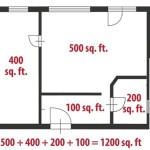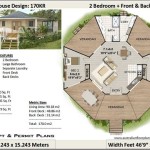How To Obtain the Floor Plan of a House
Securing a floor plan is a crucial step in understanding the layout and dimensions of a residential property. Whether for renovation projects, interior design planning, or simply to gain a comprehensive understanding of the home’s structure, possessing a floor plan offers significant advantages. Several avenues exist for obtaining these valuable documents, each with varying degrees of accessibility and required effort. This article outlines the most common methods for acquiring a house floor plan, detailing the process, potential costs, and related considerations.
Contacting the Previous Owner or Builder
One of the most direct approaches to obtaining a floor plan is to contact the previous homeowner. If the individual retained records related to the original construction or any subsequent renovations, they may possess a copy of the desired floor plan. Assuming the previous owner is accessible and amenable, this method can yield the information at little to no cost.
Similarly, if the property is relatively new, contacting the original builder or construction company may be fruitful. Builders often maintain records of projects they have completed, including architectural drawings and floor plans. This approach is particularly effective if the house was part of a larger development or built from a standard model. Contacting the builder's office, explaining the request, and providing the property address should initiate the process.
When contacting either the previous owner or the builder, be prepared to provide specific details about the property, such as the address, the year it was built, and any relevant information that may facilitate their search. A polite and professional demeanor can significantly increase the likelihood of a positive response. Be aware that even if the previous owner or builder has records, they may not be obligated to share them. Respect their decision if they decline the request.
However, relying solely on these contacts may not always be successful. Previous owners may have discarded records, and builders may no longer have files readily available, especially for older properties. Therefore, it is prudent to explore alternative methods concurrently.
Searching Public Records and Municipal Archives
Many municipalities maintain archives of building permits, property records, and architectural plans. These records are often considered public information and may be accessible to residents and property owners. The specific process for accessing these records varies from location to location, so it is essential to research the local procedures.
Begin by contacting the local building department, city hall, or county clerk's office. These entities typically oversee the maintenance of property-related documents. Inquire about the availability of floor plans for a specific property and the procedure for requesting access to these records. Some municipalities allow online access to scanned documents, while others require a physical visit to the archives.
When searching public records, be prepared to provide the property address, parcel number, and any other identifying information requested by the municipal authority. There may be fees associated with accessing and copying documents, so inquire about these costs beforehand. The availability of floor plans in public records depends on local regulations and the age of the property. Newer construction is more likely to have detailed plans on file than older buildings.
Navigating municipal archives can sometimes be challenging, as records may be organized in different ways or may be incomplete. Patience and persistence are often required to locate the desired floor plan. If difficulties arise, consider seeking assistance from a local historian, librarian, or researcher familiar with the area's historical records.
It is vital to understand the implications of utilizing publicly available floor plans. While generally accessible, there may be restrictions on their use, particularly for commercial purposes. Ensure that any intended use of the floor plan complies with local regulations and copyright laws.
Employing Professional Measurement and Drafting Services
If neither of the aforementioned methods yields the desired floor plan, a viable alternative is to engage professional services to measure and draft a plan of the house. Several companies and individuals specialize in this type of work, including architects, interior designers, and drafting professionals. This approach provides an accurate and customized floor plan tailored to the specific needs of the client.
The process typically begins with a consultation to discuss the scope of the project and the client's requirements. The professional will then visit the property to take precise measurements of each room, hallway, and exterior wall. Specialized equipment, such as laser measuring devices and digital levels, may be used to ensure accuracy. The collected measurements are then used to create a detailed floor plan using computer-aided design (CAD) software or other drafting tools.
The resulting floor plan will typically include the dimensions of each room, the location of doors and windows, and the placement of major fixtures such as plumbing and electrical outlets. Depending on the client's needs, the floor plan may also include details such as wall thicknesses, ceiling heights, and the location of structural elements. The professional can provide the floor plan in various formats, including digital files (such as PDF or DWG) and printed copies.
The cost of engaging professional measurement and drafting services varies depending on the size and complexity of the house, the level of detail required in the floor plan, and the professional's rates. It is advisable to obtain quotes from multiple providers and compare their services and pricing before making a decision. Ensure that the chosen professional has experience creating floor plans for residential properties and a reputation for accuracy and reliability.
While this method involves a financial investment, it offers several advantages. It provides an accurate and customized floor plan that reflects the current state of the property. It also eliminates the need to rely on potentially outdated or incomplete records. Furthermore, the floor plan can be used for a variety of purposes, including renovation planning, interior design, and property valuation.
Utilizing Online Resources and Software
The proliferation of online resources and software applications has made it increasingly accessible to create floor plans independently. Several user-friendly tools are available, ranging from basic web-based applications to more sophisticated software programs. These tools allow users to create floor plans by inputting measurements, dragging and dropping architectural elements, and customizing the design to their specifications.
Many online floor plan creators offer free or low-cost options for basic functionality, allowing users to create simple floor plans for personal use. More advanced features, such as 3D visualization, detailed annotation, and the ability to export the plan in various formats, may require a paid subscription or one-time purchase. Some popular online floor plan creators include RoomSketcher, Floorplanner, and SmartDraw.
Alternatively, dedicated architectural software programs, such as AutoCAD and SketchUp, offer comprehensive tools for creating detailed floor plans and architectural drawings. These programs are typically more complex to learn and use but provide a higher level of precision and customization. They are commonly used by architects, designers, and building professionals.
When utilizing online resources and software, it is essential to accurately measure the dimensions of the house. Use a measuring tape or laser measuring device to obtain precise measurements of each room and feature. Input these measurements into the software and use the tools provided to create the floor plan. Be meticulous in ensuring that the floor plan accurately reflects the layout and dimensions of the property.
While creating a floor plan independently can be a cost-effective and convenient option, it requires a certain level of technical skill and attention to detail. It may not be suitable for individuals with limited experience in drafting or architectural design. In such cases, engaging professional services may be a more practical and reliable approach.
Considerations for Accuracy and Intended Use
Regardless of the method used to obtain a floor plan, it is crucial to consider the accuracy of the document and its intended use. The level of accuracy required depends on the specific purpose for which the floor plan will be used. For example, a rough sketch may be sufficient for basic space planning, while a highly detailed and accurate floor plan is necessary for renovation projects or construction work.
When obtaining a floor plan from public records or previous owners, verify its accuracy by comparing it to the actual dimensions and layout of the house. If discrepancies are found, consider engaging professional measurement and drafting services to create an accurate and up-to-date floor plan. Ensure that the floor plan includes all relevant details, such as wall thicknesses, door and window locations, and the placement of major fixtures.
For renovation projects, it is also essential to obtain information about the structural elements of the house, such as load-bearing walls, beams, and columns. This information is crucial for ensuring the safety and structural integrity of the building. Consult with a qualified architect or structural engineer for guidance on structural modifications or alterations.
The intended use of the floor plan will also influence the format and level of detail required. For example, a floor plan used for interior design purposes may require detailed information about finishes, materials, and furniture placement. A floor plan used for property valuation purposes may need to include square footage calculations and other pertinent data.
In summary, obtaining a house floor plan requires careful consideration of various factors, including accessibility, cost, accuracy, and intended use. By exploring the available methods and carefully evaluating the options, it is possible to obtain a floor plan that meets the specific needs of the project or application.

9 Ways To Find Floor Plans Of An Existing House Blueprints Archid

Floor Plan Creator And Designer Free Easy App

House Plans How To Design Your Home Plan

House Plans How To Design Your Home Plan

Where You Can Buy House Plans Live Home 3d

House Plans How To Design Your Home Plan

5 Tips To Help You Find The Perfect House Plan Designers

9 Ways To Find Floor Plans Of An Existing House Blueprints Archid

Floor Plans Types Symbols Examples

10 Floor Plan Tips For Finding The Best House Houseplans Blog Com
Related Posts








